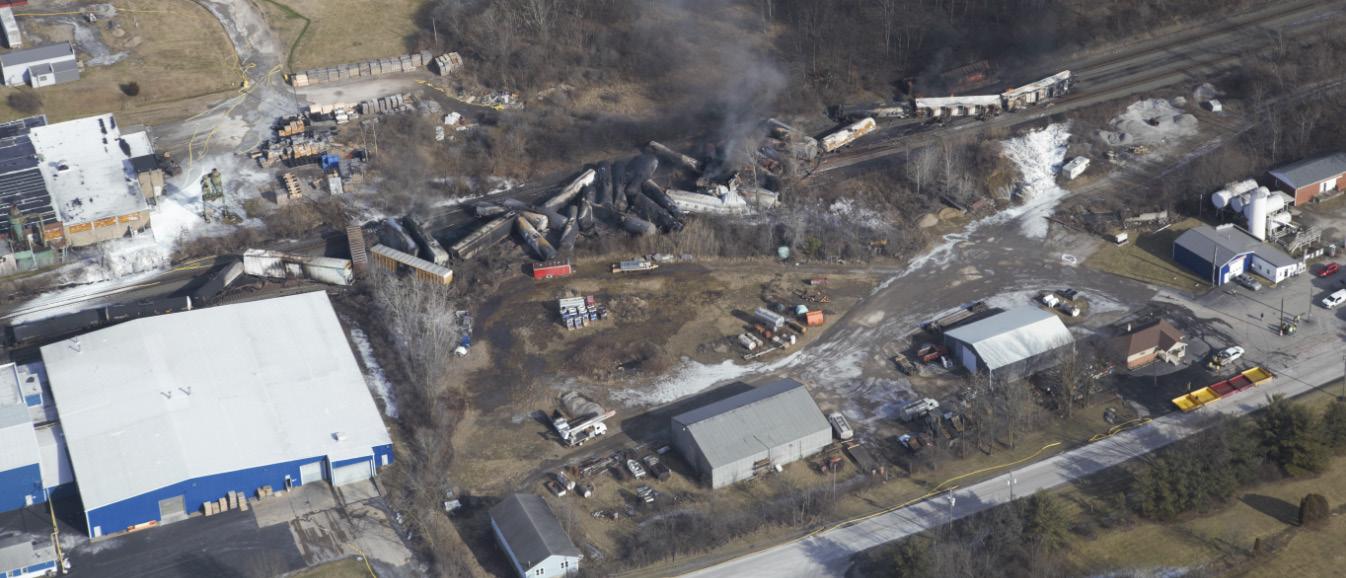
4 minute read
US RAIL FREIGHT SAFETY IS SET FOR A MAJOR OVERHAUL
Several high-profile accidents in recent months have raised fears about other and potentially more devastating incidents, with particular concerns around the transport of dangerous goods
US rail freight safety is set for a major overhaul following several high-profile accidents and derailments in recent months that have raised fears about other and potentially more devastating incidents, with particular concerns around the transport of dangerous goods.
On 8 March, the Federal Railroad Administration (FRA) announced a plan to conduct a 60-day supplemental safety assessment of Norfolk Southern Railway following multiple safety incidents, including the Norfolk Southern train derailment in East Palestine, Ohio, on February 3, which led to significant pollution of the local area. Several railcars burned for more than two days after 38 cars of a Norfolk Southern freight train carrying hazardous materials derailed in East Palestine, Ohio, United States, with emergency crews then conducting a controlled burn of several railcars at the request of state officials, which reportedly released hydrogen chloride and phosgene into the air.
The National Transportation Safety Board (NTSB), which is investigating the derailment, said the early indications suggested that a faulty wheel bearing on one rail car may have caused the derailment.
FRA said its in-depth assessment of Norfolk Southern was in addition to a number of actions taken by the US Department of Transportation over the past several weeks to improve freight rail safety and accountability to protect workers and communities.
Series of derailments
After a series of derailments and the death of one of its workers, we are initiating this further supplemental safety review of Norfolk Southern, while also calling on Norfolk Southern to act urgently to improve its focus on safety so the company can begin earning back the trust of the public and its employees. This comes as USDOT continues its own urgent actions to further improve freight rail safety and accountability.
Pete Buttigieg, US Transportation Secretary
FRA’s safety team will review the findings and recommendations of the 2022 Norfolk Southern system audit and revisit FRA’s recommendations and the scope of the railroad’s responses. In addition, FRA said it will assess the following operational elements:
• Track, signal, rolling stock maintenance, inspection, and repair practices
• Protection for employees working on rail infrastructure, locomotives, and rail cars
• Communication between transportation departments and mechanical and engineering staff
• Operation control center procedures and dispatcher training;
• Compliance with federal Hours of Service regulations
• Evaluating results of operational testing of employees’ execution and comprehension of all applicable operating rules and federal regulations
• Training and qualification programs available to all railroad employees, including engineer and conductor training and certification
• Maintenance, inspection, and calibration policies and procedures for wayside defect detectors
• Procedures related to all wayside defect detector alerts
• Measures implemented to prevent employee fatigue, including the development and implementation of fatigue management programs required as part of FRA’s Risk Reduction Program (RRP) rule
• Current status of the hazard and risk analysis required by the RRP rule
It said information collected through the supplemental safety assessment will exceed the scope of existing FRA audits, providing a more expansive look at Norfolk Southern’s overall safety culture and operations. The information gathered will be used to target specific areas for FRA’s oversight and enforcement efforts and help identify risks beyond the reach of current federal regulations. Finally, FRA will use the information collected to push the Norfolk Southern to develop measures to mitigate risks while identifying appropriate enforcement actions.
Freight railroads announce new safety measures
With the imposition of tighter safety rules now seen as inevitable, US rail freight industry representatives on 8 March announced an initial set of steps it is taking in its drive toward a future with zero incidents and zero injuries — one where what happened in East Palestine never happens again.
Concurrently, the US Department of Transportation is calling on Norfolk Southern to engage its employees and management around safety in order to protect workers and communities following Norfolk Southern incidents in Reed, PA, Bessemer, AL, Sandusky, OH, East Palestine, OH, Springfield, OH, and Cleveland, OH.
Restoring public confidence, especially in the communities in which Norfolk Southern operates, requires action beyond the six-point safety plan introduced on March 6. Given recent events, Norfolk Southern and all major freight railroads must be taking immediate steps to prioritize safety training and culture along with operational actions that match the severity of recent incidents. Norfolk Southern must prioritize the safety and well-being of its workers as well as the millions of individuals living near routes on which they operate.
The Association of American Railroads (AAR) said: The industry believes that the February 3 derailment and its aftermath require railroads and freight shippers alike to lead with actions that restore trust and that will make a difference in the march toward zero.
Healthy railroads are essential to the U.S. economy, and consistently and reliably safe operations are essential to healthy railroads. Our long history of voluntarily employing safety measures that go above and beyond federal requirements proves our belief in that principle. While we will continue to follow the National Transportation Safety Board’s ongoing investigation in Ohio closely and recognize its deliberate, methodical, and fact-based approach, railroads are committed to taking appropriate steps now.
Ian Jefferies, President & CEO, AAR
Last week AAR released data that it claimed showed that railroads are very safe and getting safer. This is especially true for hazardous material transportation, where the accident rate is down 78% since 2000. Mainline accidents are down 44% in that same period and reached an all-time low in 2022.

Jefferies added: Rail is indisputably the safest way to move dangerous commodities. Yet we fully appreciate that these data do not comfort the residents of East Palestine and that public trust must be restored through action. Until we achieve our goal of zero, we will maintain our fierce commitment to getting there. While participating in public policy discussions, railroads encourage policymakers to take an objective, data-driven approach. Policy actions taken reflexively that are not likely to achieve meaningful safety benefits could have a wide range of unintended economic and environmental consequences and a negative impact on the safe movement of all goods, including hazmat.
Will Waters, contributing editor, FORWARDER magazine
Content submission: editor@ FORWARDER magazine.us









